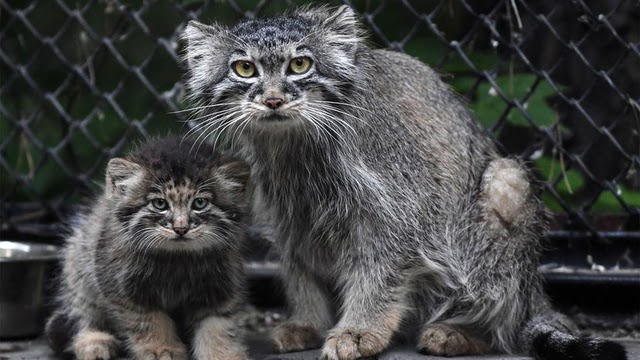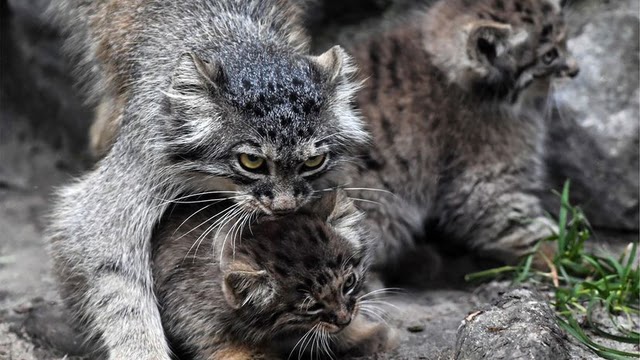Quck answer
The Pallas’s Cat, also known as the Manul, is a small wildcat that can be found in the grasslands and montane steppes of Central Asia. They are known for their unique appearance, with a round face and wide-set eyes that give them a grumpy expression. Despite their grumpy appearance, they are actually skilled predators and can hunt small rodents and birds. The Pallas’s Cat is considered a near-threatened species due to habitat loss and hunting. Conservation efforts are underway to protect this intriguing wildcat and ensure its survival.
Wild Animals

The Pallas’s cat, also known as the manul cat, is a small wildcat that is native to the steppes of Central Asia. These fluffy felines are known for their expressive faces and are found throughout Central Asia, with the largest populations in Mongolia and Russia. They are even considered a celebrity in Russia and have been the mascot for the Moscow Zoo for over 30 years.
The Pallas’s cats’ grumpy expression is due to their flat faces and large, owl-like eyes with round pupils. Despite appearing large, they are about the size of an average house cat. Their long fur, which is the longest and densest in the feline world, serves as a camouflaged winter parka and helps keep them warm in their high-altitude habitat while keeping them hidden from predators.
Pallas’s cats also have small ears that play a crucial role in their survival. Winter in the Asian steppe can be brutally cold, and large ears give off a lot of body heat. However, Pallas’s cats must also listen for rodents, so they need ears. Evolution has produced the perfect compromise.
Where Do They Live?
Pallas’s cats live throughout Central Asia, including Iran, Pakistan, Afghanistan, northern India, central China, Mongolia, and southern Russia. They prefer to stay in drier areas with less rainfall and lounge in dens they create during the day. At dusk, they emerge to hunt, mostly searching for rodents such as pikas, birds, voles, and hares. They are quite cautious animals, squatting low to the ground or behind rocks to blend in, but once ready to pounce, they are quite aggressive.

At Russia’s Novosibirsk Zoo, a Pallas’s cat is shown tending to her kittens. According to Pat Bumstead from the International Society for Endangered Cats (ISEC), Pallas’s cats are solitary creatures, with adults living alone and young cats living in family groups for up to a year after birth. This is not due to a snarky attitude, but rather because all 33 species of small cats and six of seven big cats are solitary, with lions being the only exception.
Can You Keep a Pallas’s Cat as a Pet?
Despite their cuteness, the Pallas’s cat is not suited to domestic life. Their immune system is specialized for high altitudes, and when removed from their natural habitat, their health can be severely impacted due to the increased number of bacteria and viruses found in lower areas, causing a high mortality rate in captivity. Additionally, Pallas’s cats are solitary, wild animals built to hunt, not companions for humans.
Threats and Conservation
Pallas’s cats are hunted and killed by humans for their fur and meat, which is used to make coats, hats, gloves, and other accessories, and their meat is eaten. Winter is the most dangerous time for Pallas’s cats, as they have the thickest winter fur and the most fat due to the extreme cold. Since they live in open grassland habitats, they are easily found and killed by locals. Conservation efforts are challenging due to the dangers of placing Pallas’s cats in lower altitude habitats, and captive breeding programs are not as effective as with other animals. However, scientists and conservation societies are continuing to research ways to protect the Pallas’s cat.
Did you know that Pallas’s cats change their hair color in the summer? In the winter, they have mostly solid gray coats, but in the summer, they get faint stripes and ochre-hued highlights.
FAQ
1. What is a Pallas’s cat?
A Pallas’s cat, also known as a manul, is a small wildcat native to Central Asia. It is known for its distinctive grumpy facial expression, which has led to it being called the “original grumpy cat.” The Pallas’s cat has thick fur, short legs, and a stocky build. It is a solitary animal that spends most of its time hiding in burrows or rock crevices.
2. What do Pallas’s cats eat?
Pallas’s cats primarily eat small mammals such as rodents, pikas, and ground squirrels. They may also eat birds, lizards, and insects. Due to their solitary nature and the fact that they live in remote areas, little is known about their hunting habits and prey preferences.
3. How endangered are Pallas’s cats?
Pallas’s cats are classified as “near threatened” by the International Union for Conservation of Nature (IUCN). Their population has declined due to habitat loss, hunting, and climate change. They are also sometimes hunted for their fur. Conservation efforts are underway to protect Pallas’s cat populations, including captive breeding programs and habitat restoration.
4. Can Pallas’s cats be kept as pets?
No, Pallas’s cats are wild animals and cannot be kept as pets. They require specialized care and a specific diet that is difficult to replicate in a home environment. In addition, it is illegal to own a Pallas’s cat without a special permit, and even then it is not recommended due to the stress it can cause the animal and the danger it poses to humans.
5. How can I help protect Pallas’s cats?
You can help protect Pallas’s cats by supporting conservation organizations that work to protect their habitat and prevent poaching. You can also choose to purchase products made from sustainable materials that do not harm Pallas’s cat populations. Additionally, spreading awareness about the importance of wildlife conservation can help to ensure that Pallas’s cats, and other endangered species, are protected for future generations.





Leave a Reply